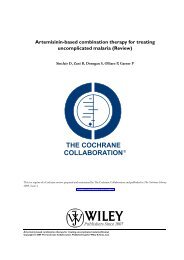Antiamoebic drugs for treating amoebic colitis - The Cochrane Library
Antiamoebic drugs for treating amoebic colitis - The Cochrane Library
Antiamoebic drugs for treating amoebic colitis - The Cochrane Library
You also want an ePaper? Increase the reach of your titles
YUMPU automatically turns print PDFs into web optimized ePapers that Google loves.
Metronidazole is considered as the drug of choice <strong>for</strong> <strong>treating</strong><br />
invasive amoebiasis (WHO 1994; Medical Letter 2004; WHO<br />
2005; AAP 2006). <strong>The</strong> standard regimen of metronidazole <strong>for</strong> the<br />
treatment of <strong>amoebic</strong> <strong>colitis</strong> is 500 to 750 mg given three times<br />
daily in adults and 30 to 50 mg/kg/day in children given <strong>for</strong> five<br />
to 10 days (WHO 1994; Medical Letter 2004; WHO 2005; AAP<br />
2006). Although there are those who believe that this dose may<br />
have sufficient activity against both trophozoites and cysts (Powell<br />
1970; WHO 1994; Li 1996), others believe that metronidazole is<br />
not reliably effective in eliminating cysts in the colonic lumen (<br />
Powell 1966; Powell 1967a; Powell 1967b; Powell 1969a; Powell<br />
1969). Thus, the general recommendation is that patients with invasive<br />
amoebiasis should receive a luminal <strong>amoebic</strong>ide after treatment<br />
with a tissue <strong>amoebic</strong>ide, in order to eliminate any surviving<br />
organisms in the colon (WHO 1995; WHO 1997; Medical Letter<br />
2004; AAP 2006). This recommendation is based on the assumption<br />
that <strong>drugs</strong> acting on different protozoal processes may enhance<br />
each other’s effect. However, the evidence to support combination<br />
therapy has not been reviewed, and it is not known whether<br />
drug combinations reduce clinical symptoms or eradicate parasites<br />
more effectively compared with giving a tissue <strong>amoebic</strong>ide alone.<br />
Furthermore, the increased complexity of combination regimens,<br />
additional drug costs, and possible increased adverse events, coupled<br />
with the unavailability of luminal agents in the market, act<br />
as major deterrents to compliance with this recommendation.<br />
Adverse effects may occur even with conventional doses of metronidazole<br />
and include headaches, loss of appetite, nausea, metallic<br />
taste, and vomiting (WHO 1995; Tracy 2001). Individuals should<br />
avoid alcoholic drinks during metronidazole therapy because of<br />
vomiting, headache, flushing, and abdominal pain that may occur.<br />
Dizziness, convulsions, poor co-ordination, and numbness<br />
of the extremities are less common but more serious adverse effects<br />
that warrant discontinuation of metronidazole (Tracy 2001).<br />
Other nitroimidazole <strong>drugs</strong> with longer half lives, such as tinidazole,<br />
ornidazole, and secnidazole, allow shorter periods of treatment<br />
and appear to be better tolerated compared with metronidazole.<br />
<strong>The</strong>se <strong>drugs</strong> have been used successfully when administered<br />
in shorter courses and have been recommended as alternative<br />
anti<strong>amoebic</strong> <strong>drugs</strong> to metronidazole (Haque 2003; Stanley<br />
2003; Medical Letter 2004; WHO 2005; AAP 2006). Treatment<br />
failures have been reported with metronidazole with most failures<br />
attributed to incorrect diagnosis, unsuitable choice of drug, or failure<br />
to observe certain principles of treatment rather than drug resistance<br />
(Knight 1980; Wassman 1999). However, the induction<br />
of metronidazole-resistant E. histolytica strains in the laboratory<br />
suggests that indiscriminate use of anti<strong>amoebic</strong> <strong>drugs</strong> can result<br />
in an increased minimum inhibitory concentration against E. histolytica<br />
(Samarawickrema 1997; Wassman 1999).<br />
A systematic review summarized the effects of different drug treatments<br />
<strong>for</strong> <strong>amoebic</strong> dysentery in endemic areas (Dans 2006). <strong>The</strong><br />
systematic review included 12 randomized controlled trials and<br />
found that while ornidazole, secnidazole, and tinidazole were likely<br />
to be beneficial <strong>for</strong> <strong>treating</strong> <strong>amoebic</strong> dysentery, metronidazole was<br />
unlikely to be beneficial. <strong>The</strong> results of the trials were not combined,<br />
and no <strong>for</strong>mal statistical methods were per<strong>for</strong>med to determine<br />
summary measures of the effectiveness of the <strong>drugs</strong>.<br />
Adequate therapy <strong>for</strong> <strong>amoebic</strong> <strong>colitis</strong> is necessary to reduce severity<br />
of illness, prevent the development of complicated disease and extraintestinal<br />
spread, and decrease infectiousness and transmission<br />
to others. In developing countries, where amoebiasis is common<br />
and most of the patients are treated in private practice or as hospital<br />
outpatients, the aim of treatment should be towards an effective,<br />
safe, and simple regimen that can be given on an outpatient basis.<br />
A reliable summary of the evidence is needed to determine the best<br />
treatment <strong>for</strong> <strong>amoebic</strong> <strong>colitis</strong>. <strong>The</strong> occurrence of treatment failures<br />
and unpleasant adverse effects associated with metronidazole in<br />
some patients and the possibility of overt clinical resistance of<br />
E. histolytica to metronidazole make it imperative to investigate<br />
alternative treatment. <strong>The</strong> benefits of using combination regimens<br />
over monotherapy and single-dose regimens over longer regimens<br />
have to be determined. Furthermore, the effectiveness of potential<br />
new anti<strong>amoebic</strong> <strong>drugs</strong> has to be ascertained.<br />
O B J E C T I V E S<br />
To evaluate anti<strong>amoebic</strong> <strong>drugs</strong> <strong>for</strong> <strong>treating</strong> <strong>amoebic</strong> <strong>colitis</strong>. <strong>The</strong><br />
review particularly aims to compare:<br />
1. single agent alternatives with metronidazole;<br />
2. any anti<strong>amoebic</strong> drug with placebo;<br />
3. combination regimens with monotherapy; and<br />
4. single-dose regimens with longer regimens.<br />
M E T H O D S<br />
Criteria <strong>for</strong> considering studies <strong>for</strong> this review<br />
Types of studies<br />
<strong>Anti<strong>amoebic</strong></strong> <strong>drugs</strong> <strong>for</strong> <strong>treating</strong> <strong>amoebic</strong> <strong>colitis</strong> (Review)<br />
Copyright © 2009 <strong>The</strong> <strong>Cochrane</strong> Collaboration. Published by John Wiley & Sons, Ltd.<br />
Randomized controlled trials. We excluded quasi-randomized trials.<br />
Types of participants<br />
Adults and children with clinical symptoms of <strong>amoebic</strong> <strong>colitis</strong> (as<br />
outlined in WHO 1997 and Haque 2003) and the demonstration<br />
of E. histolytica cysts or trophozoites in a stool sample, or<br />
E. histolytica trophozoites in a tissue biopsy or ulcer scraping by<br />
5








